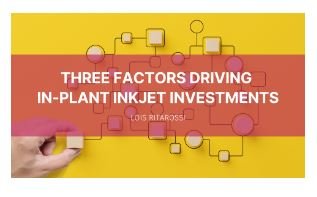Leveraging Cost Efficiency and Automation in In-Plant Consolidation
Technology innovations are impacting every facet of the healthcare industry. That means in-plant operations must evolve to continue to provide value to their organizations. Recently, I spoke with Delvecchio Shankle, Director of Operations at Christus Health about their recent transformation and continuing inkjet journey.
Over a period of seven months, Shankle’s team has successfully consolidated from five in-plant operations down to two sites and moved one operation to a new facility. His print-mail operation serves the communication needs of 29,000 Christus employees providing healthcare across 600 patient care facilities in the US, as well as patient care facilities in Mexico, Columbia, and Chile.
Inkjet driving insourcing for state in-plants
I recently spoke with two respected in-plant managers running sizable operations in their respective states. Kristen Hampton is the Division Director, Department of Technology Management & Budget, for the State of Michigan, and Tim Hendrix is the State Printer, state of Oregon Publishing & Distribution.
Hampton and Hendrix are both running fully digital shops, with a mix of inkjet and toner devices on continuous feed (CF) and cutsheet platforms. Hampton’s inkjet journey led to the elimination of offset printing. Hendrix’s recent inkjet installation is driving operational efficiency. They shared their perspective on staffing, operational cost, inkjet as an enabler and considerations for future investments.
Inkjet drives convergence of transactional and graphic arts applications
Inkjet has changed how printers define themselves. For the last 40 years five categories described the print industry. Companies would say their primary purpose was transactional, direct mail, financial, commercial or specialty print. Print buyers, procurement teams, lines of business staff, and original equipment manufacturers (OEM) sought services based on the category the company fit in.
Inkjet justification – do you know how much is outsourced?
Many for-profit and in-plant print mail operations have made significant investments in production inkjet. Each organization arrived at their decision after prioritizing the most relevant impact to their operation. The primary factors cited in the decision to move to inkjet include:
Three factors driving in-plant inkjet investments
Smaller in-plant operations are evaluating and installing production inkjet presses. In-plants in the manufacturing sector are migrating to inkjet to address a trifecta of challenges: labor resources, workflow automation, and printing costs.
Labor and training
Much has been reported about the ongoing labor challenges in many vertical markets and the printing industry in particular. In-plant operations across the U.S. are devising new strategies to address the convergence of:
Aging workers retiring, lack of skilled workers to run offset and finishing equipment, younger workers preferring to work with technology, and needing to onboard and train new employees without printing experience.
Workflow Optimization and Partnerships Driving Inkjet Investments
At the Hunkeler Innovationdays conference back in March, I spoke with several print service providers who shared their goals for growing and evolving their print and mail businesses. They also talked about challenges in production and how they are approaching new investments. The conversations brought to light three themes driving investments: innovation, workflow optimization and partnership.
Get a Guide for the Inkjet Jungle
For the last ten months my colleague, Mark Fallon, and I have been working with an in-plant to assist their team in right-sizing their print operation. In the utility sector, Salt River Project, (SRP) is a community-based, not-for-profit water and energy company. SRP provides reliable, affordable water and power to more than two million people living in central Arizona.
Many changes were underway at SRP.











